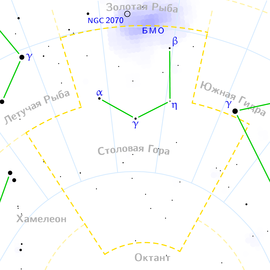Table Mountain ( Latin: Mensa , Men ) is a dim circumpolar constellation of the southern hemisphere of the sky. It covers an area of 153.5 square degrees in the sky, contains 24 stars visible with the naked eye, and does not contain stars brighter than 5 magnitudes . Within the constellation lies part of the Great Magellanic Cloud .
| Table Mountain | |
|---|---|
 | |
| Lat. title | Mensa (to the genus. n .: Mensae ) |
| Abbreviation | Men |
| Symbol | Table Mountain |
| Right ascension | 3 h 30 m to 7 h 40 m |
| Declination | −85 ° to −70 ° |
| Square | 153 sq. M. degrees ( 75 place ) |
| The brightest stars ( value <3 m ) | not; the brightest |
| Meteor showers | not |
| Nearby constellations |
|
| The constellation is visible in latitudes from + 5 ° to −90 °. | |
Observation conditions
On the territory of Russia is not observed. Full visibility only south of 5 ° north latitude. The best observation conditions are December .
History
New constellation. Proposed by Nicola Louis de Lacaille in 1754. In 1756, Lacaille proposed the French name in honor of Mount Canteen on the Cape Peninsula in South Africa , where he made astronomical observations during an expedition designed by the Paris Academy of Sciences. In 1763, after the death of Lacaille, his work Coelum Australe Stelliferum was published with the Latin version of the name of the constellation Mons Mensae . The international astronomical nomenclature has established an abbreviated version of the name - Mensa.
See also
- Table Mountain constellation stars list